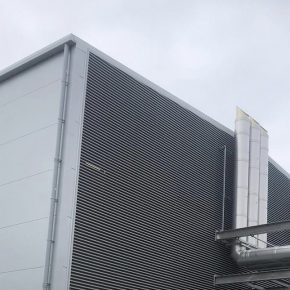
GUEST ARTICLE: Will commercial construction get left behind as firms get to grips with a new reality?
 This guest article sees James Dean, CEO and Co-founder of Sensat, talk about the changes needed to ensure that commercial construction keeps pace with the burgeoning infrastructure market amid COVID-19 setbacks, led by digital transformation.
This guest article sees James Dean, CEO and Co-founder of Sensat, talk about the changes needed to ensure that commercial construction keeps pace with the burgeoning infrastructure market amid COVID-19 setbacks, led by digital transformation.
“Although the UK construction industry has now moved into ‘phase 2’ of its post-COVID-19 recovery and the IHS Markit/CIPS construction purchasing managers’ index showed recovery in June – jumping to 55.3 points from 28.9 in May – the risk of continued disruption to the sector remains.
The last few months have shown how unpredictable life can be, with many industries forced out of action due to the global pandemic. Being largely labour-intensive and on site, construction understandably took a hit with sites shutting down to keep employees safe, and projects in March and April postponed or coming to a near grinding halt, as the nation dealt with the fall out of the lockdown.
To accelerate and ensure the future prosperity of the industry, the UK Government has recently committed to investing £640bn in infrastructure and £12bn in housing over the next five years.
This is encouraging for the construction industry as a whole, but will largely only affect government-backed projects.
The outlook for commercial construction therefore remains uncertain and with, what looks like, minimal Government support, this sector of the industry faces many challenges even as lockdown measures lift.
So, as the construction sector moves forward and workers begin ramping up projects on site again, now is the time to ask – how can we ensure commercial construction doesn’t fall too far behind in the road to recovery?
Doubling Down on Digital
The answer to a lot of challenges the commercial construction industry currently faces lies in digitisation. One of the traditional problems facing construction has been resolving the link between profit, investment and productivity.
Lower profit margins mean less money for investment in digital innovation, which in turn reduces efficiencies and harms productivity.
The UK government estimates that this productivity slump could be costing the industry as much as £15bn a year.
Traditionally, we have seen much of the work in the construction sector performed with offline tools and this has deprived the sector of the many technological advantages available over the last few decades.
Fortunately, this has begun to change in recent years, as construction companies begin to embrace the digital platforms available to them, with research suggesting that 81 percent will be taking greater leaps to improve their business digitally over the next 12 months.
For companies in the commercial construction sector, taking these much-needed steps towards digital transformation will mean they are not left behind, and can only improve the way they operate.
On top of this, as the construction sector scrambled to maintain some level of business continuity during the UK lockdown, many companies sought new ways to work remotely, which accelerated the adoption of digital tools further.
Many have now started to realise the true value of digital site and data management and are looking to incorporate this into their ‘newmailty’ and day to day working processes.
Investing in data-driven technologies
Prioritising a more holistic, digital approach to managing the entire asset lifecycle, and making technology front and centre of this approach, is now a much needed across the construction industry and businesses operating within it.
Moving forward, this will be key to supporting project delivery, controlling costs, revenue generation and ensuring continued business success, particularly for commercial construction.
While lockdown measures are easing, teams are still likely to remain widely distributed into the immediate future. To make sure that collaboration and communication can continue, there needs to be a singular source of truth for data that all site stakeholders can access in real-time and contribute to when required.
Centralising data in the cloud in this way, means activities such as survey data visualisation, tracking, decision-making and site management can continue while reducing worker contact on site.
What Does the Future Hold?
With decision-makers in both commercial and government-backed construction projects investing more in digital transformation, we are likely to see a lot of change in the coming months.
Methods of working are going to change as digital initiatives prove their worth and replace outdated practices. This will affect everything from onsite operations to more high-level strategy done in remote locations.
While there might be an initial adjustment period, if we have seen anything during the last few months, it is that people can adapt quickly and surmount new challenges.
Despite this, without increased Government investment, growth across the commercial construction may be slower but digital will most certainly help towards site management and project delivery in this new world.
One comment on “GUEST ARTICLE: Will commercial construction get left behind as firms get to grips with a new reality?”
Leave a Reply
You must be logged in to post a comment.
Latest news

3rd May 2024
Garador launches a new robust transmitter
Britain’s leading garage door manufacturer, Garador, has introduced a new robust hand transmitter designed specifically for use with its popular GaraMatic operators.
Posted in Access Control & Door Entry Systems, Architectural Ironmongery, Articles, Building Industry News, Building Products & Structures, Building Services, Doors, Facility Management & Building Services, Innovations & New Products, Retrofit & Renovation, Security and Fire Protection
3rd May 2024
Abloy UK welcomes Simon Wilson as Business Development Manager for healthcare
Abloy UK has further strengthened its team with the appointment of Simon Wilson as Business Development Manager for the Healthcare Sector.
Posted in Access Control & Door Entry Systems, Architectural Ironmongery, Articles, Building Industry News, Building Products & Structures, Building Services, Doors, Facility Management & Building Services, Health & Safety, Recruitment, Retrofit & Renovation, Security and Fire Protection
3rd May 2024
New head of marketing for Building Product Design
Leading UK manufacturer Building Product Design Ltd has promoted John Mellor to the role of head of marketing overseeing its three market-leading brands.
Posted in Articles, Building Industry News, Building Products & Structures, Building Services, Facility Management & Building Services, Insulation, Membranes, Recruitment, Restoration & Refurbishment, Roofs, Sustainability & Energy Efficiency, Walls
2nd May 2024
Gilberts Blackpool: Facing Data Centre Ventilation
Gilberts is enabling data centre architects and constructors to face the challenge of delivering a sustainable ventilation strategy.
Posted in Air Conditioning, Articles, Building Industry News, Building Products & Structures, Building Services, Facades, Facility Management & Building Services, Heating, Ventilation and Air Conditioning - HVAC, Information Technology, Restoration & Refurbishment, Retrofit & Renovation, Sustainability & Energy Efficiency, Walls

I agree that government help is vital to the quick recovery of commercial construction. Everything you wrote just makes a lot of sense.